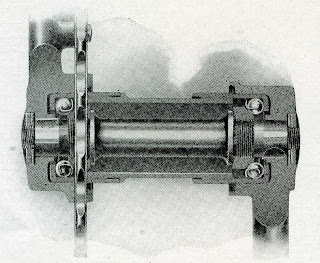The Racycle Crank got an email a few months back from a reader in California who had recently become a Racyclist. His name is Blue Nelson, and he asked whether I could help him date the Racycle Roadster he had picked up from a local Craig’s List seller. The bike was complete and looked to be in pretty good nick, but Blue thought he’d like to restore it sometime.
By the absence of a pinch-bolt binder for the seat post, I figured the bike was built somewhere from 1901 to 1908. In 1901, the Miami Cycle and Manufacturing Company dispensed with using a pinch bolt through the frame to secure the seat post and instead equipped the entire Racycle range with seat posts (from the Standard Welding Company) that used an internal-expander bolt like that used for securing the handlebar stem. However, the switch was not permanent, and by 1908 most Racycle models were back to using the pinch bolt behind the seat post. Of the six different models in the 1908 Racycle range, only the Roadster Model 135 (second picture) still retained the internal-expander seat post.
It was impossible for me to define the build date any narrower than that because the bike had no model-number badge. This is not unusual. Some badges have been lost over the years, and some individual Racycles never had a model-number badge in the first place.
As to why the maker’s use of model-number badges was inconsistent, we can speculate that perhaps these badges were left off of bikes made at the end of the model year so that unsold machines wouldn’t suffer the stigma of being last-year’s inventory. Or maybe the maker simply ran out of badges at times. It’s always fun to speculate.
 But then I noticed that Blue’s Racycle came with a bonus. It had the later “improved” crank hanger used from 1911. A crank hanger of the same vintage as the frame would have had a two-piece crank assembly with the two crank arms meeting in the centerline of the bottom bracket and working together by virtue of a set of three, coarse gear teeth (or "dogs") and held together with a draw bolt. This device is illustrated in cut-away view in the third picture. However, the later article uses a one-piece axle to which the crank arms are attached in more or less the modern way and work together by way of pins (1911 and 12) or Woodruff keys (1913 to ?) on the axle. The exploded view of the crank hanger (fourth picture) is from the 1913 catalog.
But then I noticed that Blue’s Racycle came with a bonus. It had the later “improved” crank hanger used from 1911. A crank hanger of the same vintage as the frame would have had a two-piece crank assembly with the two crank arms meeting in the centerline of the bottom bracket and working together by virtue of a set of three, coarse gear teeth (or "dogs") and held together with a draw bolt. This device is illustrated in cut-away view in the third picture. However, the later article uses a one-piece axle to which the crank arms are attached in more or less the modern way and work together by way of pins (1911 and 12) or Woodruff keys (1913 to ?) on the axle. The exploded view of the crank hanger (fourth picture) is from the 1913 catalog. It’s fun to speculate about how the bike came to have the improved crank hanger. Was it installed to satisfy a warranty claim back in 1911, or it could have been installed to sell the bike on Craig’s List?
As an aside, the factory literature uses the term “improved” to describe the later crank design, but I have not tested the two designs for comparison. Although the later design seems sound (it came with a three-year guarantee!), “improved” will be only a descriptive name until we late arrivers can determine whether it really was better than the one it replaced. Below is a cut-away view of the "improved" crank hanger with one-piece axle as provided in 1913.
Bad News
Just last month, Blue emailed with bad news. In fact, it was horrible, tragic news. He had taken the bike apart to restore it, turned over numerous irreplaceable parts to an electroplater to have them renickeled, and then the electroplater disappeared. This was too much to believe. The ghost electroplater had made shop calls, so Blue didn’t even have an address to go to for answers, just a phone number. Blue finally gave up hope and started hunting for replacement parts. The last picture here is a "before" shot of the crank assembly on Blue's Racycle. Had it and the other parts truly vanished?
Good News
But now there is good news. The electroplater showed up again at Blue’s shop. He had all of Blue’s parts, and they were all re-nickeled as promised. The plater apologized for the delay, and for not returning phone calls. In fact, he was so sorry that he gave Blue his parts for free.
Of course, Blue is as happy as a clam at high tide. He is reassembling his Racycle, and I hope I can share photos of it here soon. Blue also gave the Racycle Crank some credit for his good fortune, saying that the next time his luck runs out, he’s going to email me and wait for things to magically improve! Seems to me that that’s stretching it a little, but I suppose it’s as likely as getting your parts plated for free.







Curses, of course it should be coarse! ;-)
ReplyDeleteRoger that! Duly noted and changed. Thanks, mystery editor!
ReplyDeleteI have what I think is a 1905 raycycle single, motor. how can I verify. Thanks Bill.iknowmah@hotmail.com
ReplyDelete